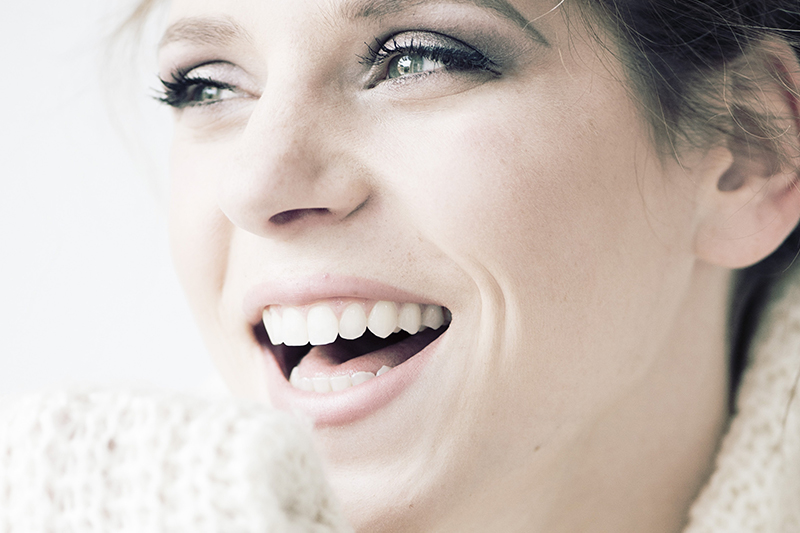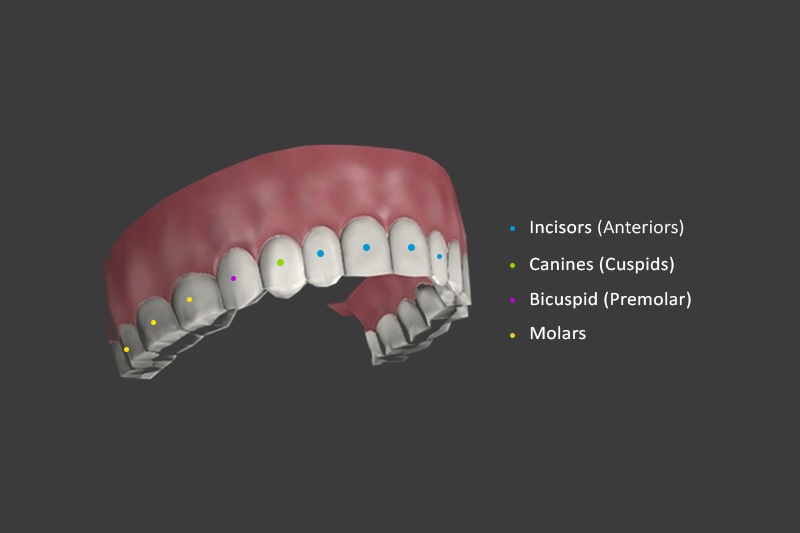Teeth Numbers and Names: Know Everything About Your Mouth
Have you ever had that feeling that when you go to the dentist you don’t know what he is talking about? Well, here is a quick guide that can help you identify teeth numbers and names, so you can understand what he’s talking about.
So, let’s start, every tooth inside our mouth has a different function, number, and name. To make things easier, teeth are divided into 4 equal sections, called quadrants.
It also helps to visualize our mouth, with its two easily identifiable curved arches, one for each jaw.
The total sum of the teeth on our jaws forms both dental arches.
We only have 2 sets of teeth during our lifetime. Although we are born with 20 baby teeth, they are hidden in our gums.
They’re called primary teeth and these erupt around the time we’re ready to eat solid foods at 6 months of age.
The second set of teeth start appearing at age 6. In a matter of years, they gradually replace all baby teeth.
Unlike sharks, these are our final and permanent teeth.
But not everybody gets their baby teeth replaced. Some retain baby teeth, even in their late adulthood.
Oddly enough, the second molar is the most likely to stay retained.

Teeth Names Explained
Teeth usually come in pairs: the front teeth are called incisors and you have 8 in total. 4 in the upper jaw and the other 4 on the bottom.
By the way, although everybody says “upper jaw”, the actual term is maxillary bone. And, the “bottom or lower jaw” is actually the mandible or jawbone. When in doubt, refer to your teeth as the position they occupy, either on the upper or lower jaw.
Let’s continue! There are 4 canines, also called fangs or cuspids. They’re on either side of the incisors, 2 on the top and 2 on the bottom. And they are called cuspid because of the single-cusped or pointed tip form.
We have 8 Premolars, which are next to the canines. Normally, there are 2 on each quadrant. Premolars are bicuspid, meaning they have 2 cusps or points.
I know this is a lot of information…
Following each pair of premolars, we have 8 to 12 molars.
We are not giving an exact number because, at the end of every row of teeth, 4 wisdom teeth might or might not have erupted yet, we can’t be sure.
Each person is different, and some might get all 4 wisdom teeth developed by age 14, some as late as 30.

Teeth Names and Numbers for Children
With children, there are a couple of differences. Children only have 20 teeth in total:
- 8 incisors, usually the 2 bottom central incisors are the first to erupt.
- 4 canines, one sitting at each row end of incisors.
- 8 molars, and that’s it!
Babies and children don’t have enough room in their mouths for more teeth.
Is not until they have a much larger skull and jawbone, that there’s room for the second set of teeth.

What About Baby Teeth?
Babies aren’t born with visible teeth. They are hidden in their gums. It could take up to 24 months for all baby teeth to emerge through the gums.
Teeth at this age serve multiple purposes. Without them, eating solid foods would be impossible and babies and children wouldn’t be able to speak clearly.
These teeth will eventually get replaced by permanent adult teeth. Still, they are fulfilling a really important task.
Most people are surprised when they find out why we develop baby teeth in the first place.
Turns out that besides needing them to chew our food, baby’s teeth are so important, that Mouth Healthy says baby teeth hold space in the jaws for permanent teeth that are growing under the gums.
That’s why whenever a baby tooth is lost too early, the permanent ones drift.
Loss of teeth can be due to poor hygiene, cavities or needed extractions. But every lost tooth can be problematic to adult teeth. The lack of teeth leads to crowding or a bad bite, making braces necessary.
When do Babies Start Teething?
When we are born, teeth are hidden beneath the gums. They start to “erupt” and break the gum line at different moments. Even when the timing is different for each baby, as per BabyCenter, the usual order of tooth eruption is:
The 2 front teeth in the lower jaw usually come out first. This can happen anytime between 6-10 months of age.
The 2 front teeth in the upper jaw come second. This can happen somewhere between the ages of 8-13 months.
The teeth on each side of the central incisors come next. They can erupt between 8-16 months. It’s common to see the bottom set first.
- Upper and Lower Molars. They come as late as 13-19 months of age.
- Canines. They sit beside the lateral incisors and erupt on both the upper and lower jaws around 16-23 months.
- Upper and Lower Molars. The second set of molars break the gum line at 25-33 months.
By the time tooth eruption is completed, the average child has turned 3 years old.

Ever Wondered Why Teeth Have Different Shapes?
As you probably noticed, teeth can be set apart not only by their position but also by the number of spikes in them. Or, as a dentist can tell you, teeth can set apart by their diverse functions.
- Incisors. The chisel-shaped front teeth. They need to be flat and sharp. Without them, you couldn’t bite into food. You use them to cut and shear food into small pieces.
- Canines. Their pointy shape helps to tear food. They can rip on foods that might be too tough, like meat.
- Premolars are flatter than canines. With premolars, there’s more biting surface than canines and incisors. They not only tear food, but they can also crush it.
- Molars. The largest. With a greater biting surface, they crush, grind and chew on food.
How many Roots does Each Tooth Have?
The number of roots varies between each tooth and by their position on the upper or lower jaw. Typically molars have 2 or 3 roots. Whereas almost all other teeth have 1 root.
- Incisors are similar to scissors in the way that they cut food. We only need 1 root for each incisor.
- Canines are the longest teeth, with 1 long and stable root. They need a deep bone attachment since they guide the bite during chewing movements.
- Premolars are transition teeth. Located between canines and molars, they can tear food just like canines or grind food like molars. The first premolar on the upper jaw tends to have 2 roots, all the others only have 1.
- Molars need to sustain strong chewing forces and because of that, they usually get anchored to your jaw by up to 4 roots.
What Are the Different Parts of a Tooth?
Each tooth can be divided into two, the crown and the root.
The crown is the only visible part of the tooth and it’s covered with enamel and dentin underneath.
The different shapes of crowns give the function to our teeth. For example, a pointy crown, like our incisors or fangs, allow them to cut food.
The root is the hidden part of the tooth. It is embedded in the jawbone. The root has to be healthy to act as a strong anchor, otherwise, tooth loss can occur.
From the outside in, these are the different parts of a tooth:
From the outside in, these are the different parts of a tooth:
Enamel
It is the hardest, outermost layer of the tooth and the most mineralized substance in your body. It’s also the most inorganic tissue, made with an average of 98% pure mineral! The main component is hydroxyapatite, is what gives enamel its crystal-like look. Enamel also has fluoride.All the chemical reactions that take place in the enamel give resistance to acid decay and help to recover lost minerals.
Enamel’s color range from milky white to light yellow. So, basically, the color of your teeth depends on how thick your enamel layer is. Acid destroys the enamel, it gets eroded when the pH in your mouth gets lower than 5.5.
To prevent tooth decay, the toothpaste needs to neutralize the pH in your mouth.
This is why brushing teeth more than 3 times a day is always recommended!
Dentin
Is the tissue beneath the enamel. When the enamel is eroded, dentin can get exposed, causing tooth sensitivity. It happens because the components and anatomy of dentin make it a highly sensitive and permeable tissue. The dentin layer is able to continue forming throughout life as a response of tooth decay and abrasion. Dentin is the bulk of the tooth and acts like a capsule for the deepest part of the tooth: the dental pulp.
Pulp
The innermost part of a tooth and it supplies with blood and nerves to the tooth. Since it is a supplier, the nutrition, restoration, and protection of teeth rely on it. Its primary job is the creation of teeth and it also gives an immunologic response when is exposed to microbes. When it gets infected, a root canal is needed. The dentin and the dental pulp are so interrelated, that they are usually considered as a whole.But there’s one major difference, the pulp doesn’t have any minerals and is limited by the mineral walls that surround it.
Cementum
A bone-like tissue that covers the root surface. It has two essential functions, it attaches the tooth to the bone and prevents the bone from reabsorbing the tooth root. The cementum tissue is deposited on our tooth roots throughout life. Since the cementum is mainly inorganic and impermeable, root canal treatment at all possible.
Teeth Numbers
While most people have learned to identify teeth by teeth names and positions, dentists refer to them by their numbers.
There are a couple of systems out there. The most popular one is called the ADA teeth numbering system. It helps to visualize the teeth in a clockwise fashion. According to it, teeth numbers 1-16 are on the upper jaw and numbers 17-32 are located in the lower jaw.
These teeth numbers are from the point of view of the dentist looking at you!
[one]
[one_second]
| UPPER RIGHT QUADRANT | |
| 8 | Central Incisor |
| 7 | Lateral Incisor |
| 6 | Canine or cuspid |
| 5 | 1st Bicuspid |
| 4 | 2nd Bicuspid |
| 3 | 1st Molar |
| 2 | 2nd Molar |
| 1 | Wisdom Tooth |
[/one_second][one_second]
| UPPER LEFT QUADRANT | |
| 9 | Central Incisor |
| 10 | Lateral Incisor |
| 11 | Canine or cuspid |
| 12 | 1st Bicuspid |
| 13 | 2nd Bicuspid |
| 14 | 1st Molar |
| 15 | 2nd Molar |
| 16 | Wisdom Tooth |
[/one_second]
[one_second]
| LOWER RIGHT QUADRANT | |
| 32 | Wisdom Tooth |
| 31 | 2nd Molar |
| 30 | 1st Molar |
| 29 | 2nd Bicuspid |
| 28 | 1st Bicuspid |
| 27 | Canine or cuspid |
| 26 | Lateral Incisor |
| 25 | Central Incisor |
[/one_second][one_second]
| LOWER LEFT QUADRANT | |
| 17 | Wisdom Tooth |
| 18 | 2nd Molar |
| 19 | 1st Molar |
| 20 | 2nd Bicuspid |
| 21 | 1st Bicuspid |
| 22 | Canine or cuspid |
| 23 | Lateral Incisor |
| 24 | Central Incisor |
[/one_second]
[/one]
Interesting Facts About Our Mouth and Teeth
- Teeth are the hardest tissue in our bodies, even more than bones!
- Teeth are not bones. Even when they may look similar to the naked eye, under the microscope it’s clear that the only thing they have in common is their whitish color and their calcium component.
- Although they are the hardest substance in the human body, we only have a limited supply of teeth on our lifetime.
- A lot of creatures are able to regrow teeth and limbs. Humans contain the DNA to regrow them too, but the ability is turned off.
- Other animals, like sharks and alligators, are polyphyodont since they are able to produce multiple sets of teeth.
A lot of crowding teeth problems are caused by the size of our jaws. The jaw size depends on genetics and the environment.
If you put it under heavy use during childhood, the jaw is under stress and tends to grow more. So, a hard diet in childhood will result in an adult with a fully developed jaw. Talk about long-term planning!
The tongue is one of the strongest muscles in our bodies. And just like fingerprints, we have a unique tongue print.
Each person’s set of teeth is also unique! Nobody has a bite or smile like yours.
